Photo
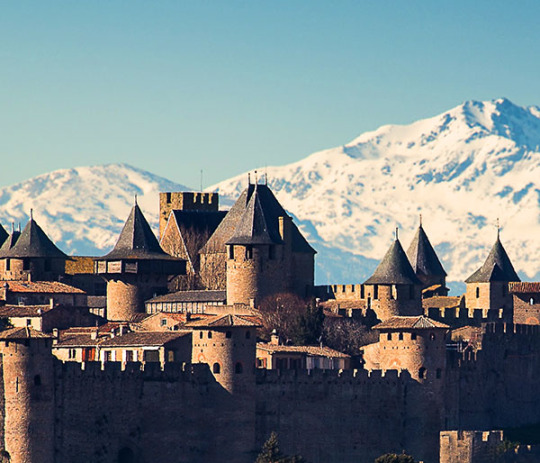
Cité de Carcassonne in winter
Aude, Languedoc (Occitanie), France.
www.catharcountry.info
Week-long tour of Cathar Castles in June 2023. See www.catharcountry.info/Week.html for details.
The Cité of Carcassonne is the largest city in Europe with its medieval city walls still intact. Although the outer curtain wall of the cité is French, and the whole site has been substantially restored, the Château Comtal has a strong claim to be called a “Cathar Castle” from the pre-French, Occitan, era. When the Catholic Crusader army arrived in 1209 they first attacked Raymond-Roger Trencavel’s castrum at Bèziers and then moved on to his main stronghold at Carcassonne. Inside the Cité is the castle of Raymond Roger Trencavel, Viscount of Carcassonne, Béziers, Albi and the Razès. He died in his own prison here in 1209, aged 24, after being taken prisoner while under a safe-conduct from the Cistercian Abbot Arnaud Amaury the papal legate and military leader of the Albigensian Crusade, who besieged Carcassonne (and who afterwards appointed Simon de Montfort as military leader of the crusade).The castle was restored in 1853 by the architect Eugène Viollet-le-Duc. It was added to the UNESCO list of World Heritage Sites in 1997.
18 notes
·
View notes
Photo

Cité de Carcassonne, Aude, Languedoc (Occitanie), France.
www.catharcountry.info
Cathar Castle Tours restarting! Week-long tour of Cathar Castles in June 2021. See www.catharcountry.info/Week.html for details
The Cité of Carcassonne is the largest city in Europe with its medieval city walls still intact. Although the outer curtain wall of the cité is French, and the whole site has been substantially restored, the Château Comtal has a strong claim to be called a “Cathar Castle” from the pre-French, Occitan, era. When the Catholic Crusader army arrived in 1209 they first attacked Raymond-Roger Trencavel’s castrum at Bèziers and then moved on to his main stronghold at Carcassonne. Inside the Cité is the castle of Raymond Roger Trencavel, Viscount of Carcassonne, Béziers, Albi and the Razès. He died in his own prison here in 1209, aged 24, after being taken prisoner while under a safe-conduct from the Cistercian Abbot Arnaud Amaury the papal legate and military leader of the Albigensian Crusade, who besieged Carcassonne (and who afterwards appointed Simon de Montfort as military leader of the crusade).The castle was restored in 1853 by the architect Eugène Viollet-le-Duc. It was added to the UNESCO list of World Heritage Sites in 1997.
113 notes
·
View notes
Photo

Château de Montségur,
Ariege, Occitanie, France.
http://www.catharcountry.info/Week.html
#OnThisDay
On the morning of 16 March 1244, some 225 Cathars were burned alive here, without trial, by the leaders of two Catholic Church armies and a French army.
A Garrison of around 200 sympathizers had defended the pacifist Cathar refugees here for ten months against combined besieging armies of 5,000 - 10,000, before the garrison was forced to surrender.
See www.catharcountry.info for 2021 Tours
65 notes
·
View notes
Photo
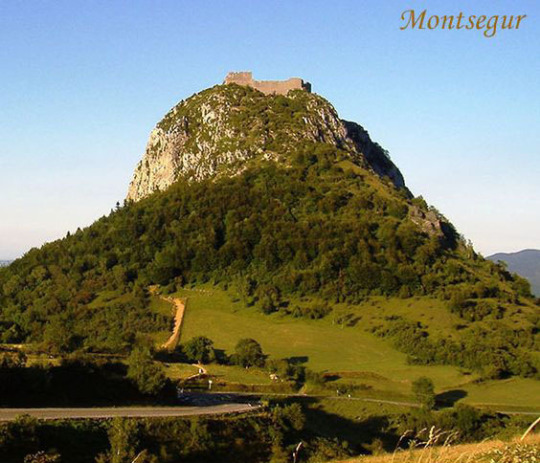
Château de Montségur,
Ariege, Occitanie, France.
http://www.catharcountry.info/Week.html
#OnThisDay
On the morning of 16 March 1244, some 225 Cathars were burned alive here, without trial, by the leaders of two Catholic Church armies and a French army.
A Garrison of around 200 sympathizers had defended the pacifist Cathar refugees here for ten months against combined besieging armies of 5,000 - 10,000, before the garrison was forced to surrender.
See www.catharcountry.info for 2020 Tours
42 notes
·
View notes
Photo
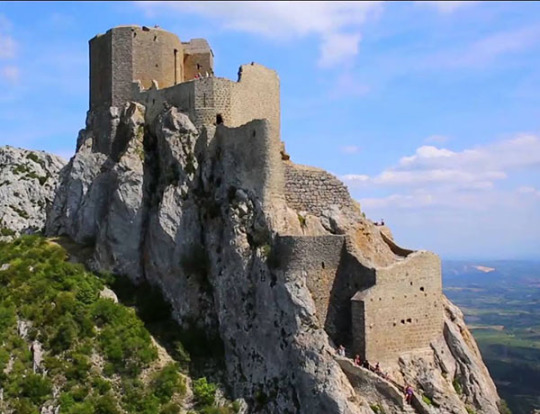
Château de Quéribus,
Cucugnan, Aude, Occianie, France.
www.catharcountry.info
Quéribus is sometimes regarded as the last Cathar stronghold. In a sense it was. After the fall of the Château of Montségur in 1244 surviving Cathars gathered together in the Corbières at this mountain-top stronghold on the border of Aragon (The present border between the Aude département and the Pyrénées-Orientales département). The Cathar deacon of the Razès, Benoît de Termes, took refuge here under Chabert de Barbaira, who was finally forced to surrender to Saint-Louis in 1255. The last stronghold to fall, eleven years after the fall of Montségur, Quéribus then became part of the French frontier defence system against Aragon.
This castle is one of the “Five Sons of Carcassonne”, along with Termes, Aguilar, Peyrepertuse and Puilaurens: five castles strategically placed to defend the new French border against the Spanish. It lost all strategic importance after the Treaty of the Pyrenees in 1659 when the border was moved even further south to its present position along the crest of the Pyrenees.
24 notes
·
View notes
Photo

Château de Montségur,
Ariege, Occitanie, France.
www.catharcountry.info
Montsegur - castle, pog and village - lies in the foothills of the Pyrenees, not far from Lavelanet. Montsegur II was a Cathar refuge besieged for ten months by three Catholic armies from May 1243, one army commanded by the Seneschal of Carcassonne, one by a bishop, and one by an archbishop.
When the castle fell in March 1244, some 225 Cathar prisoners were burned alive, without trial. A Garrison of around 200 sympathisers had defended them against the Catholic Crusader armies of 5,000 - 10,000 before they surrendered. A monument on the site reads:
IN THIS PLACE ON 16th MARCH 1244
MORE THAN 200 PEOPLE WERE BURNED.
THEY WOULD NOT ABJURE THEIR FAITH
Places still available on the Spring tour of Cathar Castles: see http://www.catharcountry.info/Week.html
20 notes
·
View notes
Photo
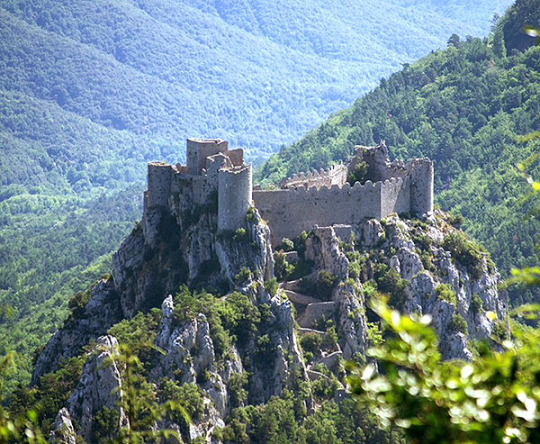
The Château de Puilaurens,
Lapradelle-Puilaurens, Aude, Occitanie, France.
www.catharcountry.info
The Château de Puilaurens (Occitan: lo Castèl de Puèg-Laurenç) is one of the Cathar Castles of the Languedoc in what is now the South of France. The castle here had belonged to the Abbey of Saint-Michel de Cuxa before it was acquired by the King of Aragon in 1162. As Aragonese property it was outside the territory ravaged by the Crusaders during the Cathar wars. Like Queribus it therefore provided a refuge for those fleeing from the invading forces. Those who took refuge there included Cathar faidits, that is to say those who had forfeited their property because of their opposition to the invaders. These faidits included high nobles, such as Guilhem de Peyrepertuse.
Places still available on the Spring tour of Cathar Castles: see http://www.catharcountry.info/Week.html
32 notes
·
View notes
Photo

Cité de Carcassonne,
Aude, Languedoc (Occitanie), France.
www.catharcountry.info
Week-long tour of Cathar Castles in June 2020. See www.catharcountry.info/Week.html for details
The Cité of Carcassonne is the largest city in Europe with its medieval city walls still intact. Although the outer curtain wall of the cité is French, and the whole site has been substantially restored, the Château Comtal has a strong claim to be called a “Cathar Castle” from the pre-French, Occitan, era. When the Catholic Crusader army arrived in 1209 they first attacked Raymond-Roger Trencavel’s castrum at Bèziers and then moved on to his main stronghold at Carcassonne. Inside the Cité is the castle of Raymond Roger Trencavel, Viscount of Carcassonne, Béziers, Albi and the Razès. He died in his own prison here in 1209, aged 24, after being taken prisoner while under a safe-conduct from the Cistercian Abbot Arnaud Amaury the papal legate and military leader of the Albigensian Crusade, who besieged Carcassonne (and who afterwards appointed Simon de Montfort as military leader of the crusade).The castle was restored in 1853 by the architect Eugène Viollet-le-Duc. It was added to the UNESCO list of World Heritage Sites in 1997.
15 notes
·
View notes
Photo

Fontfroide Abbey,
Corbieres, Languedoc, France…
www.catharcountry.info
One-week tour of Cathar Castles and related sites in the Languedoc: covering Cathar beliefs, history, origins, crusade, inquisition ….
Now taking bookings for June: contact [email protected]
Fontfroide is a Cistercian Abbey. It was at the centre of the Cistercian led crusade against the Cathars of the Languedoc in the Thirteenth century and is still in good condition.
Photo by Jan Monel.
18 notes
·
View notes
Photo

The castle at Villerouge Termenez in the Languedoc.
http://www.catharcountry.info/
This is a model of the castrum as it would have looked around 1300. It was one of numerous castles owned by the Archbishop of Narbonne who was also its temporal lord.
The archbishop burned alive here a man called Guilhem Bellibaste, the last known baptised Cathar in the Languedoc, in 1231.
For top-of-the-range historical Cathar tours in 2020 see http://www.catharcountry.info/
15 notes
·
View notes
Photo

Cité de Carcassonne,
Aude, Languedoc (Occitanie), France.
www.catharcountry.info
Week-long tour of Cathar Castles in June 2020. See www.catharcountry.info/Week.html for details
The Cité of Carcassonne is the largest city in Europe with its medieval city walls still intact. Although the outer curtain wall of the cité is French, and the whole site has been substantially restored, the Château Comtal has a strong claim to be called a “Cathar Castle” from the pre-French, Occitan, era. When the Catholic Crusader army arrived in 1209 they first attacked Raymond-Roger Trencavel’s castrum at Bèziers and then moved on to his main stronghold at Carcassonne. Inside the Cité is the castle of Raymond Roger Trencavel, Viscount of Carcassonne, Béziers, Albi and the Razès. He died in his own prison here in 1209, aged 24, after being taken prisoner while under a safe-conduct from the Cistercian Abbot Arnaud Amaury the papal legate and military leader of the Albigensian Crusade who besieged Carcassonne (and who then appointed Simon de Montfort as military leader of the crusade).The castle was restored in 1853 by the architect Eugène Viollet-le-Duc. It was added to the UNESCO list of World Heritage Sites in 1997.
50 notes
·
View notes
Photo

Château de Foix,
Foix, Ariège, France.
Places left for the week-long tour of Cathar Castles in June 2020. See www.catharcountry.info/Week.html for details.
Built on an older 7th-century fortification, the castle is known from written records in 987. In 1002 it was mentioned in the will of Roger I, Count of Carcassonne, who bequeathed it to his youngest child.
During the two following centuries, the castle was home to the Counts of Foix who were central to the Occitan resistance during the crusade against the Cathars. The county became a refuge for persecuted Cathars. The castle was often besieged (notably by Simon de Montfort in 1211 and 1212) but as one Count of Foix noted “The castle defends itself”.
The Château de Foix has been listed since 1840 as a monument historique by the French Ministry of Culture.
19 notes
·
View notes
Photo

The town of Bram, Aude, France.
www.catharcountry.info
Bram is a “circulade”, a medieval defensible walled town, besieged and taken by Catholic Crusaders in 1210, seeking to destroy Catharism. All the defenders, over 100 of them, were blinded and had their lips and noses cut off by Simon de Montfort. One man was left with one eye to lead the rest, walking to Lastours, 35 kilometers away, as a tactic to terrorise the Lord there who was a Cathar sympathiser.
39 notes
·
View notes
Photo

Le château de Termes vu depuis l’est.
Au fond à gauche le Pic Berlès.
Un cliché à retrouver sur Wikimédia commons.
11 notes
·
View notes
Photo

Aude Gate,
Cité de Carcassonne,
Aude, Languedoc (Occitanie), France.
www.catharcountry.info
One-week tour of Cathar Castles: covering Cathar beliefs, history, origins, crusade, inquisition …
Now taking bookings for September 2019
17 notes
·
View notes
Photo

Fontfroide Abbey,
Corbieres, Languedoc, France…
www.catharcountry.info
One-week tour of Cathar Castles and related sites in the Languedoc: covering Cathar beliefs, history, origins, crusade, inquisition …
Dates: 15 - 20 September 2019.
Now taking bookings: contact [email protected]
43 notes
·
View notes
Photo
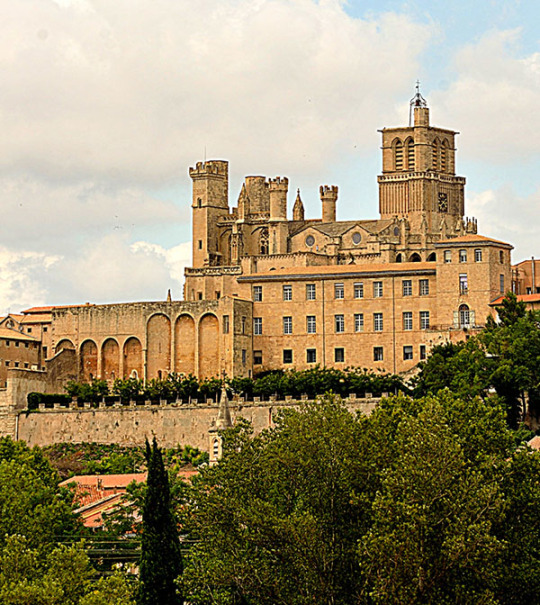
Bishop's Palace + Cathédrale Saint-Nazaire-et-Saint-Celse,
Béziers, France.
www.catharcountry.info
Béziers was the first target of the war against the Cathars (the “Albigensian Crusade”) in 1209. According to the Cistercian abbot in command, reporting to the pope after the siege of Béziers, 20,000 were killed here without regard to age, sex, or rank. Another Church source reports that 7,000 of them were burned alive in the high church during the massacre. Another reports the abbot as giving the famous instruction “kill them all, God will know his own”. The massacre was celebrated as miraculous and attributable to divine vengeance. The present structure here dates from the thirteenth century and was erected on the site of the cathedral destroyed during the mass burning in 1209.
The Trencavel lords of Béziers had a castle near the cathedral - now long gone.
8 notes
·
View notes